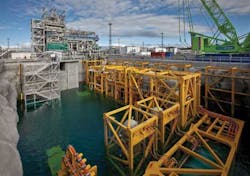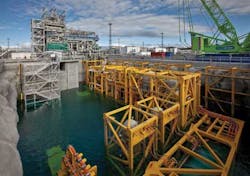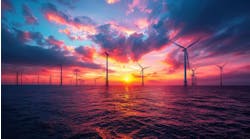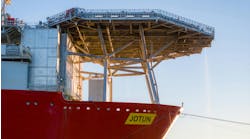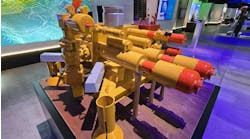Nick Terdre
Contributing Editor
Aker Solutions has developed an all-electric subsea power and control system for the Ormen Lange subsea compression pilot project in the Norwegian Sea. The equipment will be tested in an upcoming pilot program. Project operator Norske Shell said in January that performance tests would start as soon as commissioning of the equipment was completed.
The pilot system is immersed in a 14-m (46-ft) deep test pit at the Nyhamna terminal on the coast of western mid-Norway where the Ormen Lange gas is landed. On the basis of the test program, the field licensees will decide later this year whether to implement the new technology of subsea compression or stick with proven surface compression under a future-phase development.
Aker Solutions was awarded an EPC contract worth around $143 million to develop the Ormen Lange subsea compression station in 2006, while Vetco Aibel, now GE Oil & Gas, was contracted to develop the power supply to the station.
The choice of all-electric controls was taken by Norsk Hydro (since assimilated into Statoil) as it was formulating plans for the subsea compression pilot in the early part of the last decade. The thinking behind that choice is easy to understand, says Knut Nyborg, Aker Solutions' VP for Subsea Processing: the system involves several large electrical consumers and an overall power requirement of 58 MW, so the relatively small amount of power needed for an all-electric control system can easily be catered for.
Moreover, the use of hydraulic systems entails an ever-present risk to the marine environment of hydraulic fluid escaping into the sea. "By taking away the hydraulics, you simplify the umbilical and achieve a more efficient way to distribute energy to the control system," Nyborg explains.
Increasing distance and increasing depth progressively favor all-electric systems over electro-hydraulics, adds Derek Massie, project manager for the controls subproject. As the Ormen Lange system will be installed on the seabed around 125 km (77.7 mi) from shore and in a water depth close to 860 m (2,821 ft), developing a reliable hydraulic system would pose major technical challenges and would prove considerably more expensive than the all-electric alternative.
There are other advantages for all-electric controls – for example, while a hydraulic system can largely only switch valves between open and closed, an electric system can set them to any position. Again, electric actuators are relatively easy to recover, which means they have a relatively short mean time to repair compared with hydraulic actuators.
A small number of electrically operated items of subsea equipment already exist, mainly trees and actuators. But the Ormen Lange subsea compression pilot goes beyond that to a complex, full-scale development of all-electric power and control systems.
In parallel, Aker Solutions also has EPC responsibility for supplying the subsea compression system for Statoil's Åsgard field in the Norwegian Sea, which would be a world first when it comes onstream in 2015. In this case, too, the decision has been taken to go with an all-electric system. But compared with Ormen Lange, the Åsgard system requires less power, 20 MW, and involves a much shorter step-out of 40 km (24.8 mi).
Subsea energy consumers can usefully be divided into four categories, says Nyborg: pumps and compressors; the control system; electric actuators; and direct electrical heating (DEH) systems for pipelines. Pumps and compressors are high energy or high-voltage (HV) consumers; the controls and actuators are low-voltage (LV) consumers; and DEH, another technology supplied by Aker Solutions, is typically a mid-range consumer.
With the exception of DEH, the other three categories are all present in the Ormen Lange subsea compression system. As a complex system with both HV and LV consumers, this represents the ultimate challenge for an all-electric control system, Nyborg says.
The complete Ormen Lange subsea compression system consists of four 12.5-MW compressor trains. The wellstream first passes through a separator to separate the gas from the liquids. The gas then passes through a compressor unit powered by a high-speed electric motor while the liquids pass through a booster pump also powered by an electric motor. The two phases are then reunited.
Both motors are connected to variable-speed drives (VSDs) so that the speed can be altered as required. There are also uninterruptible power supply (UPS) modules to ensure safe shutdown of the system if there is a failure in the power supply from shore. And to counter the risk of a surge in the gas flow, there is an anti-surge cooler module to cool the gas.
The control system is divided into three parts:
- The process controls, which are mainly concerned with varying the speed of flow
- Process shutdown, for example, in the event of an alarm going off in the separator
- Condition monitoring, an advanced system for gathering and analyzing data, which forms the basis for fine-tuning operations and detecting whether parts of the equipment are nearing the need for replacement.
Data transmission and command signals are sent by fiber-optic cable, which means that massive amounts of data can be transmitted and that signals are received virtually in real time.
The test set-up at Nyhamna involves one complete compressor and pump train with one of each kind of module, except for the UPS modules of which there are two, in order to ensure redundant power supply for all LV consumers and to allow testing of all redundant systems. As far as possible, the pilot configuration simulates real conditions, for example making use of the Ormen Lange wellstream, although some conditions, such as distance and water depth, cannot be replicated.
Power for the subsea compression system is taken from the Norwegian grid in the form of alternating current, passing through 132-kV switchgear at the Nyhamna terminal. The voltage is slightly stepped down, to 130 kV, for transmission to the field. On arrival at the field, the power passes through a three-winding transformer which reduces the voltage in one step to 22 kV, suitable for transmission to the HV consumers.
Two separate lines then feed the power into the two circuit breaker modules, each of which is connected to two of the four compressor trains. The circuit-breaker modules contain HV and LV breakers and transformers and supply HV power to the VSD modules and LV power to the UPS modules.
From the VSDs power is passed to the compressor motors at a voltage of 6.6 kV. Each VSD regulates the speed of the motor by converting fixed frequency AC to DC and then back to AC with adjustable frequency. Sensors provide information on the pressure of the flow input into the compressor, and this feedback is used to vary the speed of the motor to ensure that the pressure is kept within the desired range. Similarly, the booster pump is used to regulate the level of liquids in the separator as well as boosting them as they leave the separator.
From the circuit-breakers, LV power is supplied to the USP modules. Each circuit breaker feeds two UPS modules which in turn supply the LV power to all LV consumers, including control power to the VSDs and power to the control system and actuators. The LV consumers also include the magnetic bearings which are used in the compressors instead of standard bearings requiring lubrication. Each consumer downstream of the UPS modules is supplied by both UPS modules, so that if one fails, it still receives power from the other. This configuration gives the system the required redundancy.
The system has been designed in modular fashion so that in the event of a malfunction, only the affected module needs to be replaced.
Aker Solutions is responsible for the overall design and development of the system, marinization, integration, and assembly. "Our philosophy for the system was to use onshore technology, known technology, installed in a one-atmosphere nitrogen enclosure, with built-in redundancy," says Nyborg. The company worked closely with a number of specialist suppliers which manufactured much of the equipment and components using detailed specifications provided by Aker Solutions.
But even the use of known technology where possible did not avoid the need for extensive qualification – the development of the control system alone required no less than 23 separate qualification programs, says Massie. Several firsts are involved – for example, the feedback loops for controlling the motor speeds are commonplace in topside control systems, but this is the first time they have been incorporated in a subsea processing system, he says.
Key challenges also had to be addressed in the power system and distribution. The connection system and penetrators represent a science in themselves, according to Jon Ola Paulsrud, specialist engineer and manager for the electric power system. Wet mateable connectors are necessary both for installation and to allow the separate removal of any malfunctioning module. They have previously been developed for subsea pumping systems, but not for the range of voltages/currents in the Ormen Lange HV system. In particular, care had to be taken over where to place the connectors, and detailed design was performed to develop these solutions.
Integrating the various components and subsystems into the delivery project in a consistent way was another challenge, as was managing the interfaces, for which Aker Solutions also had overall responsibility. "Interfacing is always difficult but it was extraordinarily difficult to do the interfaces when the parties on both sides of the interface were developing equipment," says Paulsrud.
To address this issue, an internet-based interface register was set up, accessible by the relevant main contractors and subcontractors. In addition to the information flow through the register, numerous meetings were held, both face-to-face and over the phone or net. Whenever two parties interfaced, one was given responsibility to ensure the interface was executed. Even so, Paulsrud says, the fact that interfacing parties were not able to freeze their solutions until late in the day, due to the need to qualify newly developed equipment and systems, proved challenging.
The knowledge accumulated in the course of the Ormen Lange subsea compression pilot project will stand Aker Solutions in good stead for future subsea projects where an all-electric approach may be beneficial. While the company is well equipped for future large-scale projects, Nyberg also envisions the development of simpler systems, such as an electrically operated manifold enabling distribution of power and controls to LV consumers – the attractions are the cost savings in having a lighter and simpler umbilical and no hydraulic fluids, he says.
In each case operators will assess the options and decide which technology offers the best solution. The point is that, with all-electric technology in the toolbox, there will be a choice. Aker Solutions has no doubt this technology will prove its worth in the future.
Offshore Articles Archives
View Oil and Gas Articles on PennEnergy.com
